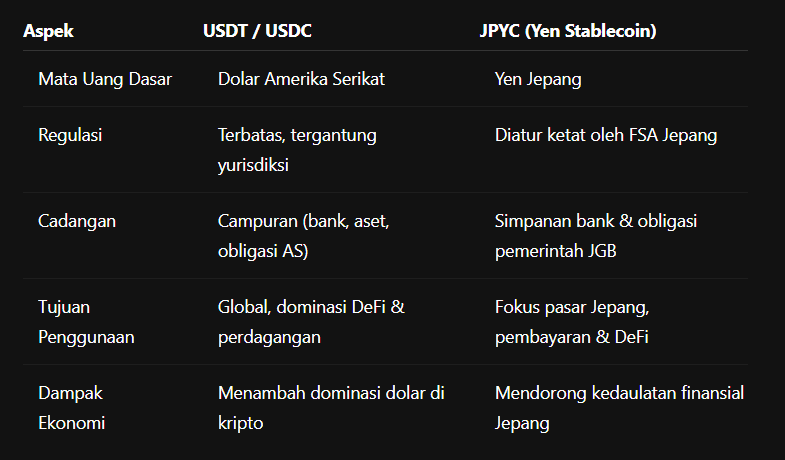The development of the digital finance world is accelerating, especially with the emergence of various forms of stablecoins backed by fiat currencies such as the US dollar. This type of stablecoin, such as USDT (Tether) or USDC (USD Coin), has become the backbone of transactions in the crypto and DeFi worlds. However, Japan has been known to be very cautious in adopting stablecoins due to regulatory, consumer protection, and financial system stability concerns.
Now, the situation is changing. The Japanese financial regulatory authority, the Financial Services Agency (FSA), is reportedly set to approve the first yen-based stablecoin named JPYC. This stablecoin is scheduled to launch in the fall of 2025.
So, what exactly is JPYC? How is its issuance mechanism? Why is Japan only taking this step now, and what impact does it have on both the domestic and global economy? This lengthy article will discuss it in detail.
What is JPYC?
JPYC is a stablecoin pegged directly to the value of the Japanese yen. This means 1 JPYC = 1 JPY. In other words, every unit of JPYC circulating on the blockchain will be fully backed by reserves in the form of liquid assets such as:
Bank deposits in Japan,
Japanese Government Bonds (JGBs).
The issuer of this token is fintech company JPYC Inc., which has been operating for quite some time in the digital asset world in Japan. After obtaining official permission as a money transfer operator, this company will be allowed to issue JPYC through a mechanism of direct bank transfers to users' digital wallets.
Technically, JPYC will use a public blockchain to be utilized in the Web3 ecosystem, DeFi, and everyday retail payments.
Why is JPYC Important?
1. Dollar Stablecoin Alternative
So far, cryptocurrency users in Japan have relied more on USDT or USDC as digital exchange tools. This has created a significant dependence on the US dollar. With the emergence of JPYC, Japan now has a domestic alternative that is more aligned with their financial system.
2. Clear Regulations
Unlike some countries that are still ambiguous regarding stablecoins, Japan already has a revised Payment Services Act (2023) that clearly regulates:
Stablecoin issuers must have official permission,
Reserves must be transparent and 100% guaranteed,
There must be regular audits to maintain public trust.
This makes JPYC one of the most regulated and secure stablecoins in the world.
3. Potential Impact on the Japanese Bond Market
JPYC plans to hold part of its reserves in the form of JGB (Japanese Government Bonds). This means this stablecoin could become a new institutional buyer for Japanese government bonds. Given that Japan has one of the largest bond markets in the world, this move has the potential to increase demand and help maintain market stability.
4. New Financial Innovations
With the existence of an official yen stablecoin, the development opportunities:
Cross-border payments become more efficient,
Integration with yen-based DeFi,
Japanese e-commerce with crypto,
will become more open.
JPYC vs Global Stablecoins
To understand JPYC's position, we need to compare it with existing global stablecoins.

This table clearly shows: JPYC is not just a copy-paste of global stablecoins, but a highly regulated Japanese version that supports the domestic economy.
Economic and Financial Impact
1. For the Japanese Financial System
Providing a legitimate digital yen alternative,
Supporting payment digitization,
Reducing the dominance of the dollar in crypto transactions in Japan.
2. For the Bond Market
If JPYC purchases JGBs for reserves, this will add stable demand for bonds. The impact:
Bond prices could be more stable,
Yields can be driven lower,
The Japanese government gains additional consistent large buyers.
3. For Consumers
The Japanese public can:
Pay with digital yen without relying on the dollar,
Use stablecoins in Japanese blockchain applications,
Feel more confident because there are clear regulatory guarantees.
4. For the Global Crypto Industry
The emergence of JPYC marks a new era: major countries are starting to develop their own fiat stablecoins. This has the potential to encourage:
Competition among cross-border stablecoins,
More integration of stablecoins in the traditional financial system,
Pressure on unregulated private stablecoins.
Potential Challenges
Although promising, JPYC also has several challenges:
Adoption: Will the Japanese public really shift from cash (which is still dominant) to stablecoins?
Competition: USDT and USDC already have a massive global ecosystem. It will take time for JPYC to compete with that.
Global Limitations: As it is yen-based, JPYC may only dominate in Japan, not internationally.
Technological Risk: Although tightly regulated, risks of hacking or smart contract bugs still exist.
JPYC and Japan's Position in the Era of Stablecoins
Japan is now positioning itself as a pioneer of local currency-based stablecoins with clear regulations. This could serve as an example for other countries, especially in Asia, to develop their national stablecoins.
In the long term, if JPYC is successful, Japan could become a center for stablecoin innovation in Asia, competing with Hong Kong and Singapore.
Conclusion
The emergence of JPYC as the first yen stablecoin in Japan is not just a technical step in the crypto world, but also a major strategy to secure financial sovereignty. With clear regulations, secure reserves, and full government support, JPYC has the potential to become a new foundation for the digital payment system in Japan.
The impact can be felt in many areas: from strengthening the Japanese government bond market, innovations in yen-based DeFi, to accelerating Web3 adoption among the Japanese public. Despite many challenges, JPYC marks the beginning of an era of legitimate and strictly regulated national currency-based stablecoins.
